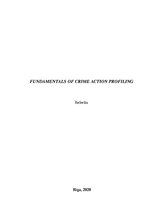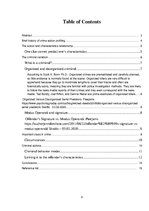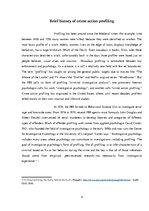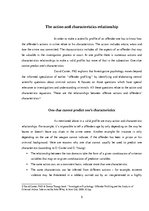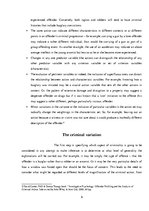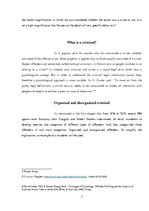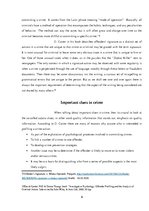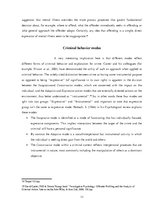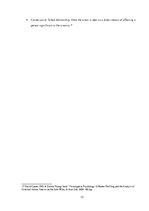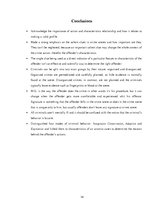-
Fundamentals of Crime Action Profiling
| Nr. | Chapter | Page. |
| Abstract | 3 | |
| Chapter 1. | Brief history of crime action profiling | 4 |
| Chapter 2. | The action and characteristics relationship | 5 |
| 2.1. | One clue cannot predict one’s characteristics | 5 |
| Chapter 3. | The criminal variation | 6 |
| 3.1. | What is a criminal? | 7 |
| 3.2. | Organized and disorganized criminal | 7 |
| 3.3. | Modus Operandi and signature | 8 |
| Chapter 4. | Important clues in crime | 9 |
| 4.1. | Circumstances | 10 |
| Chapter 5. | Criminal actions | 10 |
| 5.1. | Criminal behavior modes | 10 |
| 5.2. | Linking it to the offender’s characteristics | 11 |
| Conclusions | 13 | |
| Reference list | 14 |
Conclusions
• Acknowledge the importance of action and characteristics relationship and how it relates to making a valid profile.
• Made a strong emphasis on the salient clues in crime scenes and how important are they. They can’t be neglected, because an important salient clue may change the whole context of the crime action, therefor the offender’s characteristics.
• The single clue being used as a direct indicator of a particular feature or characteristic of the offender isn’t an effective and scientific way to determine the right offender.
• Criminals can be split into two main groups by their nature: organized and disorganized. Organized crimes are premeditated and carefully planned, so little evidence is normally found at the scene. Disorganized crimes, in contrast, are not planned and the criminals typically leave evidence such as fingerprints or blood at the scene.
• M.O. is the way the offender does the crime in other words it’s his procedure, but it can change when the offender gets more comfortable and experienced whit his offence. Signature is something that the offender lefts in the crime scene or does in the crime scene that is unique only to him, but usually offenders don’t leave any signature at crime scene.
• All criminals aren’t mentally ill and it should be confused with the notion that the criminal’s behavior is bizarre.
…
Fundametals of Crime Action Profiling/noziedznieka profilēšana pamati Šī zinātniski pamatotā pieeja nozieguma izpratnei un tā izdarīšanai palīdz tiesībaizsardzības iestādēm identificēt likumpārkāpējus un, cerams, noķert viņus. Šo ziņojumu mērķis ir izskaidrot un iepazīstināt lasītāju ar noziedzības pamatprincipiem profilēšanas / izmeklēšanas psiholoģijā. Referātā tiek apskatīta noziegumu profilēšana un to, kā tas izveidojās, likumpārkāpēja rīcības un raksturīgo attiecību nozīme un to, kāda nozīme ir pierādījumiem. Vēl tiek apskatīta noziedznieku variācijas, kā viņi tiek sadalīti trīs galvenajās grupās pēc to darbības veida. Tāpat tiek analizēts Modus Operandi un noziedznieku paraksti un tiek aprunāts vai tam ir kāda nozīme likumpārkāpēja profilēšanā. Tiks uzkaitītas un aprakstītas svarīgas norādes un pavedieni nozieguma vietās. Visbaidzot tiks apskatīta likumpārkāpēja izturēšananās - vai tā ir normāli, vai arī viņi ir garīgi slimi? Tiks apspriesti uzvedības veidi un saistīšu tos ar konkrētu likumpārkāpēja veidu, lai noteiktu pārkāpuma iemeslus.

